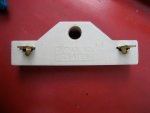Engine Won't Start: A Troubleshooting Guide
BusaDave9
Always Off-Roading Jeeper
- Posts
- 8,244
- Thanks
- 81
- Location
- Durango, Crawlarado
- Vehicle(s)
- 1979 Jeep CJ5 with 304 V8, T18 Transmission, Dana 20 Transfer case with TeraLow 3:1 gears, 4.88 axle gears, Detroit Locker up front and Ox Locker in back with 1 piece axle shafts, 36" SuperSwamper SX Tires, Shackle reversal, MileMarker Hydraulic winch, MSD 6A ignition.
If your jeep won't start there are a number of things that could be causing the problem.
If your engine was running recently but won't today there are 3 areas to concentrate on:
1. Starting system to turn the engine over until it can run on it's own.
2. Fuel making it into the cylinders.
3. Spark igniting the fuel.
Now keep in mind there are several other things needed for an engine to run. Things such as air, compression and timing. You usually don't loose these things suddenly one day. As an engine ages the compression gradually lowers. It keeps running but performance goes down gradually. Air flow into the engine usually doesn't stop suddenly one day. Air is one of those things I assume your engine has. It is possible for a timing chain to jump teeth on the timing gear. This will cause the engine to run but run rough. If the timing chain were to break the engine would crank over but not start. It's uncommon for a timing chain to break.
For these reasons this thread will not be the end all for troubleshooting an engine that won't start. If you follow this thread and your engine still won't start please post a new thread and let us know what you already tried. And for the sake of sanity, please tell us up front any changes you made to your engine before it failed to start. We don't want to hear 6 pages into the thread “oh, didn't I tell you, I just replace my distributor the day before it wouldn't start?”
98% of all engines that were running recently but won't start today have a problem with one of these 3 areas: starting system, fuel or spark.
This troubleshooting guide can be used for any Jeep CJ engine. Actually it can be used for most older engines.
If your engine was running recently but won't today there are 3 areas to concentrate on:
1. Starting system to turn the engine over until it can run on it's own.
2. Fuel making it into the cylinders.
3. Spark igniting the fuel.
Now keep in mind there are several other things needed for an engine to run. Things such as air, compression and timing. You usually don't loose these things suddenly one day. As an engine ages the compression gradually lowers. It keeps running but performance goes down gradually. Air flow into the engine usually doesn't stop suddenly one day. Air is one of those things I assume your engine has. It is possible for a timing chain to jump teeth on the timing gear. This will cause the engine to run but run rough. If the timing chain were to break the engine would crank over but not start. It's uncommon for a timing chain to break.
For these reasons this thread will not be the end all for troubleshooting an engine that won't start. If you follow this thread and your engine still won't start please post a new thread and let us know what you already tried. And for the sake of sanity, please tell us up front any changes you made to your engine before it failed to start. We don't want to hear 6 pages into the thread “oh, didn't I tell you, I just replace my distributor the day before it wouldn't start?”
98% of all engines that were running recently but won't start today have a problem with one of these 3 areas: starting system, fuel or spark.
This troubleshooting guide can be used for any Jeep CJ engine. Actually it can be used for most older engines.












